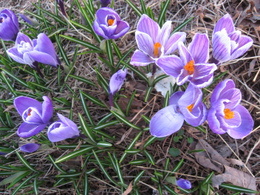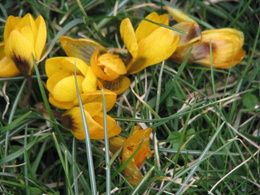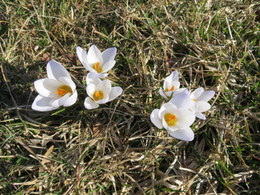Crocus Growing Guide
Crocus (Crocus spp.) is a perennial early spring blooming flower native to Eastern Europe, North Africa and Asia. Their early blooms are a welcome addition to every flower garden. They bloom from March and April often with some snow on the ground. They are hardy in USDA Zones 3 to 9 and will do well in full sun to part sun.
Dutch crocus is the most common spring blooming variety found in garden centers in the fall. They are often sold in bags of mixed bulbs with colors of purple, yellow, white and striped bi-color blooms.
When purchasing your bulbs (actually corms) look for the largest ones, which will have the most energy stored up. Reject any that are small or shriveled up.
There are many varieties available which will determine the time of blooming. Sunny locations and protected areas next a building foundation will bloom earlier.
For some added interest in your fall blooming garden add some varieties that bloom in the fall. In the spring they will send up thin strap-like leaves looking much like the other varieties. Its blooms show up in the fall when not much else is blooming. They are not usually found in garden centers, but can be ordered online.
If you enjoy cooking you should consider planting the ‘saffron crocus’. Each flower has 3-red stigmas which are removed by hand with tweezers and dried.
Saffron is regarded to be the world's most costly spice by weight. It may take 2 or 3-dozen flowers to supply the home gardener with enough spice.
Soil Preparation
Plant your bulbs in full sun to part sun in a nice loose well-drained garden soil. Till the soil by digging down 8 to 12-inches turning the soil over with a garden fork. Remove any large rocks and stones. The small stones remaining will do no harm and actually benefit the soil by adding some micronutrients to the soil. They will do best in a slightly acid soil with a pH range of 6.0 to 7.0.
When to Plant
All varieties should be planted in the fall before the ground freezes. A good time is when the soil temperature drops below 60-degrees F. The bulb needs a period of time to develop a good root system before the ground freezes. In most areas this will be around the end of October or early November.
Planting Crocus
Follow the grower’s instructions. In general plant the bulbs 2 to 3-inches deep and 3 to 4-inches apart. For the best visual affect plant the bulbs in groups of 3 or 5.
When planting the bulbs, place the bulb with the pointed end up. After planting the bulbs, cover with a light layer of mulch to conserve moisture and protect the new bulbs during the winter.
They are often sold in bags of 10 or 20-bulbs and a large mass planting is very attractive. Water your bulbs every 7 to 10-days for good root development until the ground freezes.
Watering and Care
They are low maintenance and easy to care for. All you need to do is add a layer of mulch to help retain moisture and keep out competing weeds. Your bulbs should get an inch of water each week during their growing and blooming season and during dry spells give some water to keep the soil moist.
They usually do not need any fertilizer, but a light side dressing of low nitrogen slow release 3-5-3 organic fertilizer such as Espoma Bulb Tone can be applied. Following the directions, apply around the bulbs when planting and after they have finished blooming.
If planted in the lawn do not remove the foliage until it has yellowed and died back. This will put more energy back into the bulb for next year’s blooms. Mow around the area until the foliage has yellowed. Do not plant in the lawn if any herbicides or pesticides have been applied.
Diseases and Pests
They are usually trouble free. Buy inspected bulbs and do not plant any bulbs that look moldy or look infected in any way. Proper well-drained soil is important. Dig up any infected plants and put in the trash, not the compost pile.
They are rarely bothered by deer, squirrels, and rabbits.
Popular Varieties
Spring blooming:
Ankara crocus (Crocus ancyrensis)
Crocus Tricolor (Crocus sieberi)
Dutch crocus (Crocus vernus)
Golden Yellow (Crocus flavus)
Snow crocus (Crocus chrysanthus)
Snow crocus (Crocus tommasinianus)
Fall blooming:
Autumn Crocus (Crocus goulimyi)
Crocus medius (Crocus ligusticus
Mount Atos Crocus (Crocus pulchellus)
Saffron crocus (Crocus sativus)
Bieberstein’s crocus (Crocus speciosus)
Sources: American Meadows, Eden Brothers, White Flower Farm.
Garden Spikes newsletters give you timely information once or twice a month. Subscribe Free to the Garden Times newsletter below.
Your email address will only be used to send you a newsletter and will never be sold. You can unsubscribe at any time.



